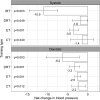Muscular Strength in Risk Factors for Cardiovascular Disease and Mortality: A Narrative Review
- PMID: 35924286
- PMCID: PMC9403882
- DOI: 10.5152/AnatolJCardiol.2022.1586
Muscular Strength in Risk Factors for Cardiovascular Disease and Mortality: A Narrative Review
Abstract
Cardiovascular disease is the leading cause of death globally, accounting for approximately 32% of all deaths in 2019. There has been increasing interest in understanding the role of low muscular strength as a risk factor for cardiovascular disease, given its association with other cardiovascular risk factors such as hypertension, diabetes mellitus, and metabolic syndrome. An inverse association between muscle strength, chronic disease, all-cause mortality, and cardiovascular-related death has been reported. Recent clinical trials have consistently shown that resistance exercise, which increases strength, and potentially muscle mass, significantly improves the control of known cardiovascular disease risk factors and reduces the risk of all-cause death and cardiovascular mortality. In the present article, we review the growing body of evidence that supports the need for future research to evaluate the potential of handgrip strength as a screening tool for cardiovascular disease and its risk factors in the clinical medical setting, as part of routine care using an affordable handgrip strength device. Moreover, it is crucial to devise largescale interventions driven by governmental health policies to educate the general population and healthcare professionals about the importance of muscular strengthening activities and to promote access to these activities to improve cardiometabolic health and reduce incidence of cardiovascular disease and mortality.
Figures

References
-
- World Health Organizarion [internet]. Cardiovascular diseases (CVDs) Fact sheet; 2021.. Available at: https://www.who.int/news-room/fact-sheets/detail/cardiovascular-diseases...; Cited 2022 March 4.
-
- Yusuf S, Joseph P, Rangarajan S.et al. Modifiable risk factors, cardiovascular disease, and mortality in 155 722 individuals from 21 high-income, middle-income, and low-income countries (PURE): a prospective cohort study. Lancet. 2020;395(10226):795 808. 10.1016/S0140-6736(19)32008-2) - DOI - PMC - PubMed
Publication types
MeSH terms
LinkOut - more resources
Full Text Sources

